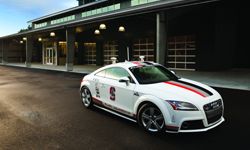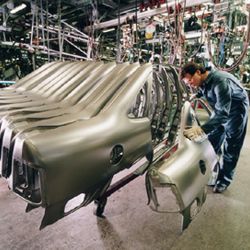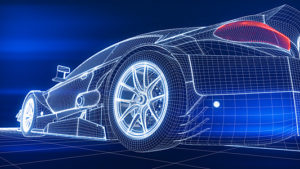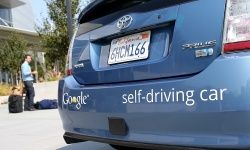\”

In the technology world, the latest advancement is only as good as the next thing coming down the line. The auto industry is constantly bringing us new technologies, whether it be for safety, entertainment, usefulness or simply for pure innovation.
Many new car technologies are either specifically built for safety or at least have some sort of safety focus to them. Some of the latest car innovations we\’ve found are some truly exciting technologies that could revolutionize not just the automotive industry but human transportation in general.
So what\’s in store for future cars? Well, we don\’t know for sure, but based on what\’s currently being tested and what\’s on the road today, we have an idea of some new technology that will most likely make it into production. Some of it will help keep us safe, some will give us information like never before and some will let us kick back and just enjoy the ride.
Read the next page to begin learning about five future car technologies.
Contents
- Cars That Communicate with Each Other and the Road
- Self-driving Cars
- Augmented Reality Dashboards
- Airbags That Help Stop Cars
- Energy-storing Body Panels
5: Cars That Communicate with Each Other and the Road
Car manufacturers and the U.S. government are seriously looking into and researching two technologies that would enable future cars to communicate with each other and with objects around them.
Imagine approaching an intersection as another car runs a red light. You don\’t see them at first, but your car gets a signal from the other car that it\’s directly in your path and warns you of the potential collision, or even hits the brakes automatically to avoid an accident. A developing technology called Vehicle-to-Vehicle communication, or V2V, is being tested by automotive manufacturers like Ford as a way to help reduce the amount of accidents on the road.
V2V works by using wireless signals to send information back and forth between cars about their location, speed and direction. The information is then communicated to the cars around it in order to provide information on how to keep the vehicles safe distances from each other. At MIT, engineers are working on V2V algorithms that calculate information from cars to determine what the best evasive measure should be if another car started coming into its own projected path. A study put out by the National Highway Traffic Safety Administration in 2010 says that V2V has the potential to reduce 79 percent of target vehicle crashes on the road [source: Green Car Congress].
But researchers aren\’t only considering V2V communication, vehicle-to-infrastructure communication, or V2I, is being tested as well. V2I would allow vehicles to communicate with things like road signs or traffic signals and provide information to the vehicle about safety issues. V2I could also request traffic information from a traffic management system and access the best possible routes. Reports by the NHTSA say that incorporating V2I into vehicles, along with V2V systems, would reduce all target vehicle crashes by 81 percent [source: Green Car Congress].
These technologies could transform the way we drive and increase automotive safety dramatically. Good thing car companies and the government are already working to try to make this a reality.
All of this communication and preemptive vehicle assistance leads us into our next future technology, so go on to the next page to find out what it is.
4: Self-driving Cars


The idea of a self-driving car isn\’t a new idea. Many TV shows and movies have had the idea and there are already cars on the road that can park themselves. But a truly self-driving car means exactly that, one that can drive itself, and they\’re probably closer to being a reality than you might think.
In California and Nevada, Google engineers have already tested self-driving cars on more than 200,000 miles (321,869 kilometers) of public highways and roads [source: Thrun]. Google\’s cars not only record images of the road, but their computerized maps view road signs, find alternative routes and see traffic lights before they\’re even visible to a person. By using lasers, radars and cameras, the cars can analyze and process information about their surroundings faster than a human can.
If self-driving cars do make it to mass production, we might have a little more time on our hands. Americans spend an average of 100 hours sitting in traffic every year [source: Cowen]. Cars that drive themselves would most likely have the option to engage in platooning, where multiple cars drive very close to each and act as one unit. Some people believe platooning would decrease highway accidents because the cars would be communicating and reacting to each other simultaneously, without the on-going distractions that drivers face.
In some of Google\’s tests, the cars learned the details of a road by driving on it several times, and when it was time to drive itself, it was able to identify when there were pedestrians crossing and stopped to let them pass by. Self-driving cars could make transportation safer for all of us by eliminating the cause of 95 percent of today\’s accidents: human error [source: Truong].
Although self-driving cars may seem far off, GM has already done its own testing and some people believe that you\’ll see some sort of self-driving car in showrooms in the next decade.
Go on to the next page to learn how we may be viewing all of our car\’s data in the near future.
3: Augmented Reality Dashboards
GPS and other in-car displays are great for getting us from point A to point B, and some high-end vehicles even have displays on the windshield, but in the near future cars will be able to identify external objects in front of the driver and display information about them on the windshield.
Think of the Terminator, or many other science fiction stories, where a robot looks at a person or an object and automatically brings up information about them and can identify who or what they are. Augmented Reality dashboards, AR for short, will function in a similar way for drivers. BMW has already implemented a windshield display in some of their vehicles which displays basic information, but they\’re also developing augmented reality dashboards that will be able to identify objects in front a vehicle and tell the driver how far they are away from the object. The AR display will overlay information on top of what a driver is seeing in real life.
So if you\’re approaching a car too quickly, a red box may appear on the car you\’re approaching and arrows will appear showing you how to maneuver into the next lane before you collide with the other car. An augmented reality GPS system could highlight the actual lane you need to be in and show you where you need to turn down the road without you ever having to take your eyes off the road.
BMW is also researching the use of augmented reality for automotive technicians. They produced a video where a BMW technician uses AR glasses to look at an engine, identify what parts need to be replaced and then shows step-by-step instructions on how to fix it.
AR is also being researched for passengers as well. Toyota has produced working concepts of their AR system that would allow passengers to zoom in on objects outside of the car, select and identify objects, as well as view the distance of an object from the car using a touch-screen window.
Augmented reality may not be here yet, but if these car companies have their way, we\’ll be seeing it in our future cars a little ways down the road.
Go on to the next page to learn about a new use for an old technology.
2: Airbags That Help Stop Cars
Ever since airbags were been added to vehicles, they\’ve continued to make their way around the inside of our vehicles. We now have curtain airbags, side airbags, knee airbags, seat belts airbags and even ones that deploy under us. Maybe all of us don\’t have them in our cars, but they\’re on the road. And Mercedes is working on a new way to use airbags that moves them away from a passive safety measure and makes it part of an active safety system.
Mercedes is experimenting with airbags that deploy from underneath the car that will help stop a vehicle before a crash. The airbags are part of the overall active safety system and deploy when sensors determine that at impact is inevitable. The bags have a friction coating that helps slow the car down and can double the stopping power of the vehicle. The bags also lift the vehicle up to eight centimeters, which counters the car\’s dipping motion during hard braking, improves bumper-to-bumper contact and helps prevent passengers from sliding under seat belts during a collision.
What gives this kind of airbag potential as a future technology is that it uses existing vehicle safety systems. Although Mercedes has been working on this technology for several years, it isn\’t available on any production models yet and may not be seen on the road for another few years.
With the current evolution of airbags and their pervasiveness within the automotive world, it wouldn\’t be a stretch to imagine future cars using airbags to not only protect passengers, but to actually stop cars as well.
Go on to the next page to learn about the next future car technology.
1: Energy-storing Body Panels


Exxon Mobil predicts that by 2040, half of all new cars coming off the production line will be hybrids [source: Kahn]. That\’s great news for the environment, but one of the problems with hybrids is that the batteries take up a lot of space and are very heavy. Even with advances in lithium-ion batteries, hybrids have a significant amount of weight from their batteries. That\’s where energy-storing body panels come in.
In Europe, a group of nine auto manufacturers are currently researching and testing body panels that can store energy and charge faster than conventional batteries of today. The body panels being tested are made of polymer fiber and carbon resin that are strong enough to be used in vehicles and pliable enough to be molded into panels. These panels could reduce a car\’s weight by up to 15 percent [source: Volvo].
The panels would capture energy produced by technologies like regenerative braking or when the car is plugged in overnight and then feed that energy back to the car when it\’s needed [source: Volvo]. Not only would this help reduce the size of hybrid batteries, but the extra savings in weight would eliminate wasted energy used to move the weight from the batteries.
Toyota is also looking into lightweight energy storing panels, but they\’re taking it one step further and researching body panels that would actually capture solar energy and store it in a lightweight panel [source: Bey].
Whether future body panels collect energy or just store it, automotive companies are looking into new ways to make our cars more energy efficient and lightweight.
For more information about future car technologies and other related topics, follow the links on the next page.
Lots More Information
Related Articles
- Top 5 Reasons You Don\’t Want a Flying Car
- 5 Things You Didn\’t Know About Automotive Testing
- 5 Flying Car Prototypes
- How Flying Cars Will Work
- How Automotive Proving Grounds Work
- How much does it cost to build a concept car?
- What keeps concept cars from making it to market?
Sources
- Bey, Thomas. "Top 10 Future Vehicle Technologies." Ask Men. (Dec. 15, 2011) http://www.askmen.com/top_10/cars/top-10-future-vehicle-technology_4.html
- Birch, Stuart. "External airbag slows car in a crash." Telegraph. June 11, 2009. (Dec. 15, 2011) http://www.telegraph.co.uk/motoring/road-safety/5495705/External-airbag-slows-car-in-a-crash.html
- BMW. "BMW Augmented Reality." (Dec. 15, 2011) http://www.bmw.com/com/en/owners/service/augmented_reality_introduction_1.html
- Cowen, Tyler. "Can I See Your License, Registration and C.P.U.?" The New York Times. May 28, 2011. (Dec. 14, 2011) http://www.nytimes.com/2011/05/29/business/economy/29view.html
- Green Car Congress. "Ford showcasing vehicle-to-vehicle communication for crash avoidance; potential for leveraging WiFi and smartphones to extend quickly the number of participating vehicles." July 19, 2011. (Dec. 14, 2011) http://www.greencarcongress.com/2011/07/fordv2v-20110719.html
- Guizzo, Erico. "How Google\’s Self-Driving Car Works." Discovery News. Oct. 18, 2011. (Dec. 13, 2011) http://news.discovery.com/autos/how-google-self-driving-car-works-111018.html
- Kahn, Chris. "Exxon Mobil Predicts Surge in Hybrid Vehicles." MSNBC. Dec. 8, 2011. (Dec. 16, 2011) http://www.msnbc.msn.com/id/45596879/ns/business-autos/t/exxon-mobil-predicts-surge-hybrid-vehicles/#.TuuWvyNWpGg
- Motoring File. "BMW Group Developing Augmented Reality Window Displays." Oct. 12, 2011. (Dec. 14, 2011) http://www.motoringfile.com/2011/10/12/bmw-group-developing-augmented-reality-windshield-displays/
- Ramsey, Jonathan. "VIDEO: Mercedes-Benz ESF S400 Concept\’s "Braking Bag" in action." Autoblog. June 14, 2009. (Dec. 15, 2011)http://www.autoblog.com/2009/06/14/video-mercedes-benz-esf-s400-concepts-braking-bag-in-action/
- Thrun, Sebastian. "Leave the Driving to the Car, and Reap Benefits in Safety and Mobility." Dec. 5, 2011. (Dec. 12, 2011) http://www.nytimes.com/2011/12/06/science/sebastian-thrun-self-driving-cars-can-save-lives-and-parking-spaces.html
- Truong, Alice. "Do Driverless Cars Offer Safer and More Efficient Transportation?" Discovery.com. Oct. 11, 2011. (Dec. 13, 2011) http://dsc.discovery.com/cars-bikes/do-driverless-cars-offer-safer-and-more-efficient-transportation.html
- Volvo. "Tomorrow\’s Volvo Car: Body Panels Serve as the Car\’s Battery." Sept. 24, 2010. (Dec. 15, 2011) http://www.volvocars.com/intl/top/about/news-events/pages/default.aspx?itemid=209
- Yvkoff, Liane. "Toyota Demos Augmented-Reality-Enhanced Car Windows." CNET. July 21, 2011. (Dec. 15, 2011) http://reviews.cnet.com/8301-13746_7-20081402-48/toyota-demos-augmented-reality-enhanced-car-windows/












